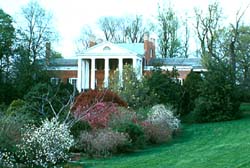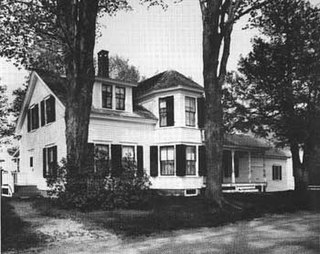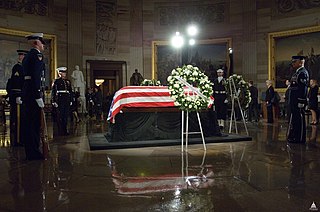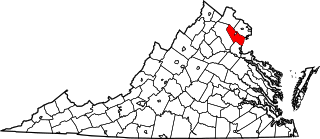
Elizabeth Anne Ford was the first lady of the United States from 1974 to 1977, as the wife of President Gerald Ford. As first lady, she was active in social policy and set a precedent as a politically active presidential spouse. Ford also was the second lady of the United States from 1973 to 1974 when her husband was vice president.

Gerald Ford's tenure as the 38th president of the United States began on August 9, 1974, upon the resignation of president Richard Nixon, and ended on January 20, 1977. Ford, a Republican from Michigan, had been appointed vice president since December 6, 1973, following the resignation of Spiro Agnew from that office. Ford was the only person to serve as president without being elected to either the presidency or the vice presidency. His presidency ended following his narrow defeat in the 1976 presidential election to Democrat Jimmy Carter, after a period of 895 days in office.

Oak Hill is a mansion and plantation located in Aldie, Virginia that was for 22 years a home of Founding Father James Monroe, the fifth U.S. President. It is located approximately 9 miles (14 km) south of Leesburg on U.S. Route 15, in an unincorporated area of Loudoun County, Virginia. Its entrance is 10,300 feet (3,100 m) north of Gilberts Corner, the intersection of 15 with U.S. Route 50. It is a National Historic Landmark, but privately owned and not open to the public.

Fair Lane was the estate of Ford Motor Company founder Henry Ford and his wife, Clara Ford, in Dearborn, Michigan, in the United States. It was named after an area in Cork in Ireland where Ford's adoptive grandfather, Patrick Ahern, was born. The 1,300-acre (530 ha) estate along the River Rouge included a large limestone house, an electrical power plant on the dammed river, a greenhouse, a boathouse, riding stables, a children's playhouse, a treehouse, and extensive landmark gardens designed by Chicago landscape architect Jens Jensen.

The Kennedy Compound consists of three houses on six acres of waterfront property on Cape Cod along Nantucket Sound in Hyannis Port, Massachusetts, in the United States. It was once the home of Joseph P. Kennedy, an American businessman, investor, politician, and U.S. ambassador to the United Kingdom; his wife, Rose; and their children, including U.S. President John F. Kennedy and U.S. Senators Robert F. Kennedy and Edward M. Kennedy. As an adult, the youngest son, Edward, lived in his parents' house, and it was his primary residence from 1982 until he died of brain cancer at the compound, in August 2009.

The Eisenhower Executive Office Building (EEOB), formerly known as the Old Executive Office Building (OEOB), and originally known as the State, War, and Navy Building, is a United States government building that is now part of the White House compound in the U.S. capital of Washington, D.C. Maintained by the General Services Administration, the building currently houses the Executive Office of the President, including the Office of the Vice President of the United States. Opened in 1888, the building was renamed in 1999 in honor of Dwight D. Eisenhower, the 34th U.S. president and a five-star U.S. Army general who was Allied forces commander during World War II.

Lyndon B. Johnson National Historical Park is a United States National Historical Park in central Texas about 50 miles (80 km) west of Austin in the Texas Hill Country. The park protects the birthplace, home, ranch, and grave of Lyndon B. Johnson, 36th president of the United States. During Johnson's administration, the LBJ Ranch was known as the Texas White House because the President spent approximately 20% of his time in office there.

Gerald Rudolph Ford Jr. was an American politician who served as the 38th president of the United States from 1974 to 1977. He previously served as the leader of the Republican Party in the U.S. House of Representatives from 1965 to 1973, and as the 40th vice president under President Richard Nixon from 1973 to 1974. Ford succeeded to the presidency when Nixon resigned in 1974, but was defeated for election to a full term in 1976. Ford is the only person to serve as President and Vice President without being elected to either office.

The Coolidge Homestead, also known as Calvin Coolidge Homestead District or President Calvin Coolidge State Historic Site, was the childhood home of the 30th president of the United States, Calvin Coolidge and the place where he first took the presidential oath of office. Located in Plymouth Notch, Vermont, Coolidge lived there from age four in 1876 to 1887, when he departed for Black River Academy for education. He is buried in Plymouth Notch Cemetery not far from the home.

The President Gerald R. Ford Jr. Boyhood Home is a house located at 649 Union Avenue SE in Grand Rapids, Michigan that is listed on the National Register of Historic Places. Future President Gerald R. Ford lived in the house from 1921 through 1930, when he was between the age of 8 and 17. Of all his boyhood homes, Ford remembered this one most vividly in his autobiography.

Parkfairfax is a neighborhood in Alexandria, Virginia, United States, located in the northwestern part of the city near the boundary with Arlington County. Nearby thoroughfares are Interstate 395, State Route 402, and West Glebe Road.

The Mary McLeod Bethune Home is a historic house on the campus of Bethune-Cookman University in Daytona Beach, Florida. Built in the early-1900s, it was home to Mary McLeod Bethune (1875-1955), a prominent African-American educator and civil rights leader, from 1913 until her death. It was designated a United States National Historic Landmark in 1974 It is now managed by the Mary McLeod Bethune Foundation as a historic house museum.

On December 26, 2006, Gerald Ford, the 38th president of the United States, died at his home in Rancho Mirage, California at 6:45 p.m. local time. At 8:49 p.m. local time, his wife of 58 years, Betty Ford, issued a statement announcing his death. The causes of death listed on the death certificate were arteriosclerotic cerebrovascular disease and diffuse arteriosclerosis.

The Bradford–Pettis House is a historic house located at 400 South 39th Street in Midtown Omaha, Nebraska. It was designated an Omaha Landmark on February 26, 1980, and added to the National Register of Historic Places on July 21, 1983.

The Edsel and Eleanor Ford House is a mansion located at 1100 Lake Shore Drive in Grosse Pointe Shores, northeast of Detroit, Michigan; it stands on the site known as "Gaukler Point", on the shore of Lake St. Clair. The house became the new residence of the Edsel and Eleanor Ford family in 1928. Edsel Ford was the son of Henry Ford and an executive at Ford Motor Company. The estate's buildings were designed by architect Albert Kahn, its site plan and gardens by renowned landscape designer Jens Jensen. The property was listed on the National Register of Historic Places in 1979, and was designated a National Historic Landmark in 2016.

This is a list of the National Register of Historic Places listings in Prince William County, Virginia.

The Gerald R. Ford Presidential Museum is the presidential museum and burial place of Gerald Ford, the 38th president of the United States (1974–1977), and his wife Betty Ford. It is located near the Pew Campus of Grand Valley State University in Grand Rapids, Michigan. Ford's presidential museum is the only such facility under the auspices of the National Archives and Records Administration to be separate from the presidential library, which is located approximately 130 miles (210 km) to the east in Ann Arbor. Despite the separation, the library and museum are a single institution with one director.

Richardson Brognard Okie Jr. (1875-1945) was an American architect. He is noted for his Colonial-Revival houses and his sensitive restorations of historic buildings.

Proclamation 4311 was a presidential proclamation issued by President of the United States Gerald Ford on September 8, 1974, granting a full and unconditional pardon to Richard Nixon, his predecessor, for any crimes that he might have committed against the United States as president. In particular, the pardon covered Nixon's actions during the Watergate scandal. In a televised broadcast to the nation, Ford, who had succeeded to the presidency upon Nixon's resignation, explained that he felt the pardon was in the best interests of the country and that the Nixon family's situation was "a tragedy in which we all have played a part. It could go on and on and on, or someone must write the end to it. I have concluded that only I can do that, and if I can, I must."
The following is a timeline of the presidency of Gerald Ford from August 9, 1974, when Ford became the 38th president of the United States, upon the resignation of Richard Nixon, to December 31, 1974.

























